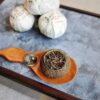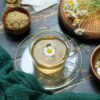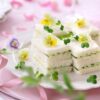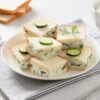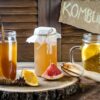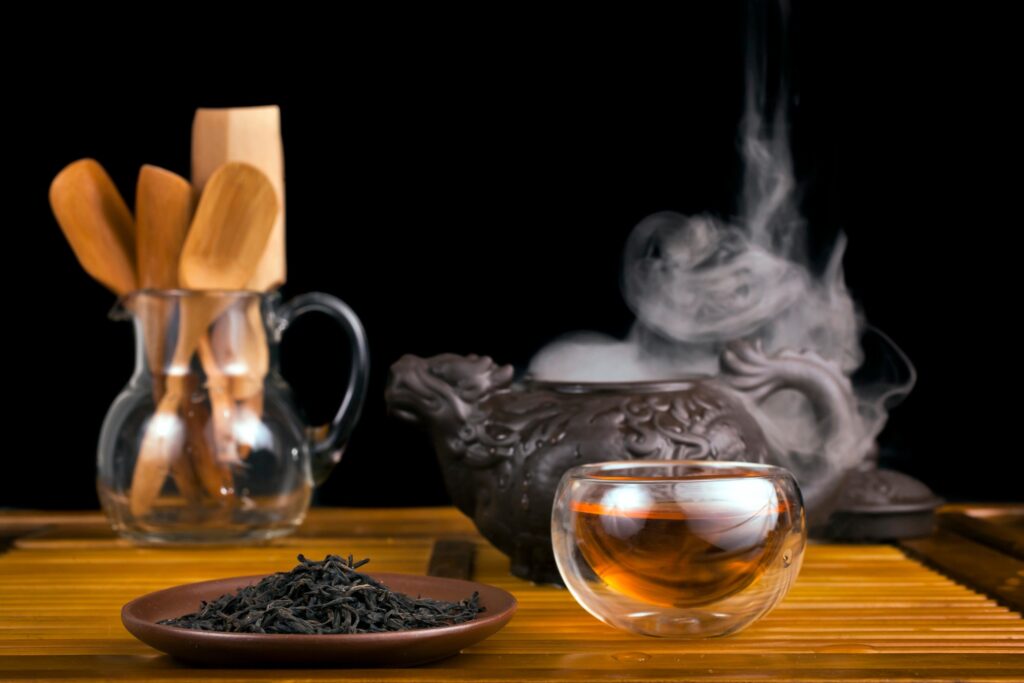
Are you ready to embark on a journey of the senses? Get ready to discover the intriguing world of Lapsang tea, renowned for its enchanting aroma and smoky flavor. This distinctive Chinese black tea is unlike anything you’ve ever tasted before.
Imagine stepping into a cozy wooden cabin in the mountains, where a crackling fire fills the air with its smoky and woody scent. Now, take a sip of Lapsang tea, and you’ll be transported to that very moment. The tea leaves are carefully withered over pinewood fires, infusing the leaves with a unique smoky aroma that is simply irresistible.
But Lapsang tea is not just about its smokiness. It also boasts a smooth and full-bodied flavor, with hints of fruit, caramel, and even chocolate. Whether enjoyed hot or iced, this tea is a true delight for the senses.
The history and origin of Lapsang tea
Lapsang tea has a rich history that dates back several centuries. Legend has it that the tea was first discovered during the Qing Dynasty in the Wuyi Mountains of Fujian, China. It is said that the tea leaves were accidentally left to wither and oxidize over pine fires when the village was under attack. The villagers, unable to wait for the leaves to dry naturally, decided to speed up the process by exposing them to the smoke of the fires. This accidental discovery gave birth to Lapsang tea and its unique smoky flavor.
Lapsang tea quickly gained popularity, both in China and abroad. It became a favorite among European traders during the 17th and 18th centuries. Today, Lapsang tea is still primarily produced in the Wuyi Mountains, where the traditional methods of production have been passed down through generations. The region’s unique climate and soil conditions contribute to the tea’s distinctive flavor profile.
Lapsang tea is also known by different names, such as Zheng Shan Xiao Zhong or Bohea tea. These names refer to the specific cultivars and growing regions of Lapsang tea. However, the term “Lapsang” is widely used to encompass all variations of this smoky tea.
The production process of Lapsang tea
The production of Lapsang tea involves several meticulous steps to achieve its characteristic smoky aroma. It all starts with the careful selection of tea leaves, typically from the Zheng Shan Xiao Zhong cultivar. These leaves are plucked by hand and then subjected to a withering process, where they are spread out and left to dry for a specific period of time. This withering process helps to reduce the moisture content of the leaves and prepare them for the next step.
Once withered, the leaves are pan-fried to halt the oxidation process. This step is crucial in preserving the tea’s unique flavor profile. After pan-frying, the leaves are rolled and shaped to release the tea’s natural oils. It is during this stage that the leaves are carefully arranged on bamboo trays and exposed to pinewood fires. The smoke from the fires infuses the leaves, giving Lapsang tea its distinct smoky aroma.
The final step in the production process is the drying and sorting of the tea leaves. They are spread out in a cool, dry area to remove any remaining moisture. Once dry, the leaves are sorted based on their size and quality. The highest quality leaves are carefully packaged and prepared for distribution, ready to be enjoyed by tea enthusiasts around the world.
The distinct flavor profile of Lapsang tea
Lapsang tea is renowned for its bold and smoky flavor, which sets it apart from other teas. The smokiness of Lapsang tea is reminiscent of a crackling fire, with its distinctive woody and smoky aroma. It is this unique flavor profile that has captivated tea lovers for centuries.
Apart from its smokiness, Lapsang tea also offers a range of other flavors that add depth and complexity to each sip. The tea has a smooth and full-bodied taste, often accompanied by hints of fruit, caramel, and even chocolate. These flavor notes combine harmoniously to create a truly unforgettable tea experience.
The intensity of the smoky flavor can vary depending on the specific Lapsang tea variety and the production methods used. Some varieties may have a milder smokiness, allowing the other flavor notes to shine through. Others may have a more robust and pronounced smokiness, providing a sensory explosion for the taste buds.
Health benefits of Lapsang tea
In addition to its captivating aroma and flavor, Lapsang tea also offers a range of health benefits. Like other black teas, Lapsang tea contains antioxidants that help to protect the body against free radicals and reduce the risk of chronic diseases. These antioxidants, known as polyphenols, have been linked to various health benefits, including improved heart health and reduced inflammation.
Lapsang tea is also known to contain caffeine, providing a gentle energy boost to help you stay focused and alert. The caffeine content in Lapsang tea is lower than that of coffee, making it a popular choice for those who are sensitive to caffeine or prefer a milder stimulant.
Additionally, Lapsang tea is believed to aid digestion and promote weight loss. The tea has been used in traditional Chinese medicine to improve digestion and relieve gastrointestinal issues. It is also thought to boost metabolism and help the body burn calories more efficiently.
While Lapsang tea offers numerous health benefits, it is important to consume it in moderation, as excessive consumption of caffeine can have adverse effects on certain individuals.
How to brew the perfect cup of Lapsang tea
Brewing Lapsang tea requires a few simple steps to ensure that you extract the best flavors from the leaves.
- Start by heating water to the appropriate temperature, around 195°F (90°C). Avoid using boiling water, as it can scorch the delicate tea leaves and result in a bitter brew.
- Measure out the desired amount of tea leaves. A general guideline is to use 1 teaspoon of loose tea leaves per 8 ounces of water. Adjust the amount based on your personal preference for a stronger or milder brew.
- Place the tea leaves in a teapot or infuser. Pour the heated water over the leaves and let them steep for about 3-4 minutes. Adjust the steeping time based on your preferred strength of the tea.
- Once the steeping time is up, strain the tea leaves or remove the infuser from the teapot. Pour the brewed tea into cups and savor the delightful aroma and flavors of Lapsang tea.
Remember, brewing tea is a personal preference, and you can adjust the brewing parameters to suit your taste. Experiment with different steeping times and tea-to-water ratios to find the perfect balance that pleases your palate.
Lapsang tea variations and blends
While traditional Lapsang tea offers a unique and captivating flavor, there are also variations and blends available for those who want to explore different taste profiles.
One popular variation is Lapsang Souchong, which is made from the same tea leaves but undergoes a different production process. Lapsang Souchong is known for its smoky and earthy flavors, with a milder smokiness compared to traditional Lapsang tea.
Blending Lapsang tea with other teas or herbs can also create interesting flavor combinations. For instance, blending Lapsang tea with Earl Grey tea adds a citrusy twist to the smoky base. Other popular blends include Lapsang tea with jasmine or mint, offering a refreshing and aromatic experience.
The possibilities for Lapsang tea variations and blends are endless, allowing tea enthusiasts to explore and discover new flavor profiles that suit their preferences.
Lapsang tea in culinary applications
Lapsang tea’s unique smoky flavor makes it a versatile ingredient in culinary applications. Beyond being enjoyed as a hot or iced beverage, Lapsang tea can be used to infuse flavor into various dishes and desserts.
One popular culinary use of Lapsang tea is in savory recipes, such as marinades for meats or as a smoky seasoning for grilled vegetables. The tea’s smokiness adds depth and complexity to these dishes, creating a delightful sensory experience.
Lapsang tea can also be incorporated into sweet treats, such as cookies, cakes, and chocolates. The tea’s smoky and woody notes pair well with rich and indulgent flavors, adding a unique twist to traditional desserts.
For those who enjoy experimenting in the kitchen, Lapsang tea provides endless possibilities to elevate your culinary creations and surprise your taste buds.
Where to buy Lapsang tea and popular brands
Lapsang tea can be found in specialty tea shops, gourmet markets, and online retailers. When purchasing Lapsang tea, it is important to choose a reputable brand that offers high-quality tea leaves.
Here are a few popular brands known for their exceptional Lapsang tea:
- Wuyi Star: This brand specializes in Lapsang tea from the Wuyi Mountains, ensuring authenticity and high-quality leaves.
- Teavivre: Teavivre offers a wide range of Chinese teas, including Lapsang tea. Their selection includes different variations, allowing you to explore different flavor profiles.
- Harney & Sons: Known for their premium teas, Harney & Sons offers a Lapsang Souchong blend that combines the smoky flavor of Lapsang tea with other black teas.
When purchasing Lapsang tea, be sure to check the packaging for information on the tea’s origin, production methods, and brewing recommendations. This will help you make an informed decision and ensure that you’re getting the best quality tea.
As we come to the end of our journey through the world of Lapsang tea, it’s clear that this unique Chinese black tea offers a sensory experience like no other. From its enchanting aroma to its distinct smoky flavor, Lapsang tea captivates tea lovers with its allure.
Whether you’re a seasoned tea enthusiast or new to the world of tea, Lapsang tea is certainly worth exploring. Its rich history, meticulous production process, and versatile flavor profile make it a tea that is both intriguing and satisfying.
So, brew yourself a cup of Lapsang tea, close your eyes, and let the smoky aroma transport you to that cozy wooden cabin in the mountains. Discover the magic of Lapsang tea and indulge in its captivating allure. Cheers to the smoky sensation of Lapsang tea!

